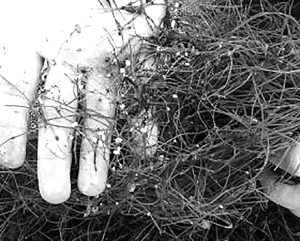Correction on MLA and starry stonewort battle
Published on July 10, 2023 at 2:02pm CDT
Publisher’s Perspective
By Tim Douglass, Publisher of the Pope County Tribune
It is with our apologies that the Pope County Tribune & Starbuck Times is correcting a statement made in last week’s issue. The Tribune-Times stated incorrectly that the Minnewaska Lake Association (MLA) helped fund the hand pulling of starry stonewort from the Starbuck Marina.
The hand pulling was funded by the City of Starbuck. MLA was not involved at all. In fact, as a Letter to the Editor in this issue states, the MLA has been in contact with the DNR and the University of Minnesota Aquatic Invasive Species Research Center and both organizations have published documents stating that manually pulling starry stonewort, an invasive plant “could speed the spread due to fragments floating” in the water.
MLA board members have repeatedly asked the City of Starbuck to stop manually pulling the invasive plant from the Starbuck Marina and expressed that concern at a recent Starbuck City Council meeting.
The Pope County Tribune regrets the error.
What is starry stonewort

Starry stonewort (Nitellopsis obtusa) is a large, submerged plant-like algae that can form dense mats in lakes and ponds. These mats can interfere with boating, fishing, waterfowl hunting, swimming and other recreation. Starry stonewort may choke out native plant communities. Native to Europe and Asia, starry stonewort was first observed in the St. Lawrence River in 1978. This species can spread overland to new waters by clinging to watercraft, trailers, and equipment. Only male starry stonewort has been documented in the United States, so no “seeds” are produced. It produces small, starchy growths called bulbils, and these bulbils or fragments of the stem can spread starry stonewort to new locations. Eradicating established starry stonewort infestations is nearly impossible.
Starry stonewort was first confirmed in Minnesota in August 2015, in Lake Koronis and connected Mud Lake (Stearns County).
Starry stonewort was first identified in the Starbuck Marina, just off of Lake Minnewaska in 2017. Only 13 lakes in Minnesota are listed as infested with starry stonewort. The Minnesota Department of Natural Resources (DNR) has a list of waters infested with invasive species including Eurasian watermilfoil and zebra mussels.
What can you do?
The public can help stop the spread of aquatic invasive plants and zebra mussels by taking three steps every time a boater leaves a lake or river – whether or not it’s infested:
•Clean all aquatic plants, zebra mussels, and other invasive species from boats, trailers, and water-related equipment.
•Drain water from your boat, ballast tanks, motor, live well and bait container. Remove drain plugs and keep drain plugs out while transporting equipment.
•Dispose of unwanted bait in the trash. To keep live bait, drain the water and refill the bait container with bottled or tap water.




